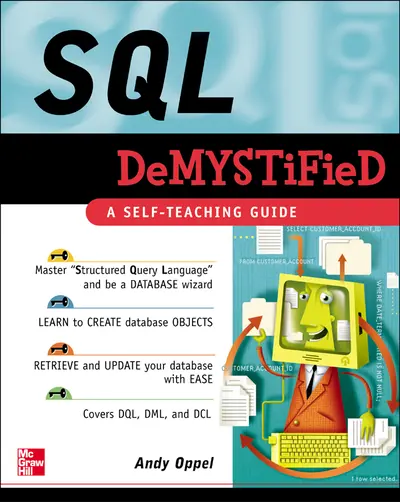My Account Details

ISBN10: 0072262249 | ISBN13: 9780072262247

Step 1 . Download Adobe Digital Editions to your PC or Mac desktop/laptop.
Step 2. Register and authorize your Adobe ID (optional). To access your eBook on multiple devices, first create an Adobe ID at account.adobe.com. Then, open Adobe Digital Editions, go to the Help menu, and select "Authorize Computer" to link your Adobe ID.
Step 3. Open Your eBook. Use Adobe Digital Editions to open the file. If the eBook doesn’t open, contact customer service for assistance.
Publisher's Note: Products purchased from Third Party sellers are not guaranteed by the publisher for quality, authenticity, or access to any online entitlements included with the product. There’s no easier, faster, or more practical way to learn the really tough subjects SQL Demystified explains how to use SQL (Structured Query Language)--the ubiquitous programming language for databases. Readers will learn to create database objects, add and retrieve data from a database, and modify existing data. This self-teaching guide comes complete with key points, background information, quizzes at the end of each chapter, and even a final exam. Simple enough for beginners but challenging enough for advanced students, this is a lively and entertaining brush-up, introductory text, or classroom supplement.
Chapter 1: Relational Database ConceptsChapter 2: SQL ConceptsChapter 3: Defining Database Objects Using SQLChapter 4: Retrieving Data Using Data Query Language (DQL)Chapter 5: Combining Data From Multiple TablesChapter 6: Advanced Query WritingChapter 7: Maintaining Data Using DMLChapter 8: Applying Security Controls Using Data DCLChapter 9: Preserving Database Integrity Using TransactionsChapter 10: Integrating SQL into ApplicationsChapter 11: SQL Performance Tuning ConsiderationsFINAL EXAMANSWERS TO QUIZZES AND FINAL EXAMINDEX
Chapter 3: Defining Database Objects Using SQLChapter 4: Retrieving Data Using Data Query Language (DQL)Chapter 5: Combining Data From Multiple TablesChapter 6: Advanced Query WritingChapter 7: Maintaining Data Using DMLChapter 8: Applying Security Controls Using Data DCLChapter 9: Preserving Database Integrity Using TransactionsChapter 10: Integrating SQL into ApplicationsChapter 11: SQL Performance Tuning ConsiderationsFINAL EXAMANSWERS TO QUIZZES AND FINAL EXAMINDEX
Chapter 5: Combining Data From Multiple TablesChapter 6: Advanced Query WritingChapter 7: Maintaining Data Using DMLChapter 8: Applying Security Controls Using Data DCLChapter 9: Preserving Database Integrity Using TransactionsChapter 10: Integrating SQL into ApplicationsChapter 11: SQL Performance Tuning ConsiderationsFINAL EXAMANSWERS TO QUIZZES AND FINAL EXAMINDEX
Chapter 7: Maintaining Data Using DMLChapter 8: Applying Security Controls Using Data DCLChapter 9: Preserving Database Integrity Using TransactionsChapter 10: Integrating SQL into ApplicationsChapter 11: SQL Performance Tuning ConsiderationsFINAL EXAMANSWERS TO QUIZZES AND FINAL EXAMINDEX
Chapter 9: Preserving Database Integrity Using TransactionsChapter 10: Integrating SQL into ApplicationsChapter 11: SQL Performance Tuning ConsiderationsFINAL EXAMANSWERS TO QUIZZES AND FINAL EXAMINDEX
Chapter 11: SQL Performance Tuning ConsiderationsFINAL EXAMANSWERS TO QUIZZES AND FINAL EXAMINDEX
ANSWERS TO QUIZZES AND FINAL EXAMINDEX
Need support? We're here to help - Get real-world support and resources every step of the way.